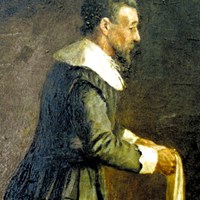Origins of the Industry 1589 - 1750
Where it all started, covering the woollen industry the origins of knitting across the East Midlands.
Hand knitting in England expanded as an industry in Tudor times (1485-1603). Knitted caps and stockings were highly fashionable.
Find out moreThe English woollen industry pre-dates the arrival of the Romans. The Norman invasion in the eleventh century encouraged the industry to expand, and fleeces and cloth were exported across Europe.
Find out moreDuring the early seventeenth century, knitting frames remained an expensive investment and few were built. Even in the 1660s, frames could cost as much as £20 to £30 each, more than a worker's yearly wage.
Find out moreSilk stockings that copied the Italian fashion leaders were highly prized from their introduction in England in Tudor times. Worsted knitting had located itself in the East Midlands by the start of the eighteenth century, but the silk industry remained in London a little longer.
Find out moreThe use of cotton for weaving had been established in seventeenth century Lancashire. At this time cotton yarn was irregular in thickness and tended to break at thin, weak points.
Find out moreAs hosiery was a fashion industry, colours and patterning were of vital importance from its earliest years.
Find out moreJames Lee returned to London in 1612. He brought seven framework knitters and eight frames with him and set up a small industry. Workers and their apprentices gradually created rules by which the industry and the prices charged could be controlled.
Find out more





